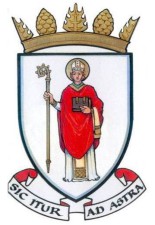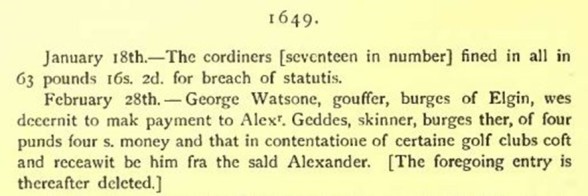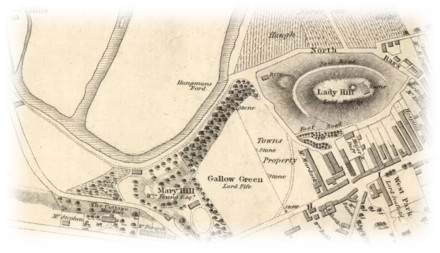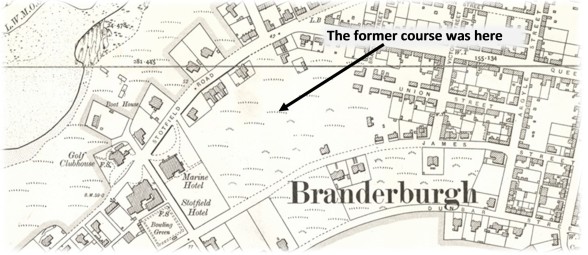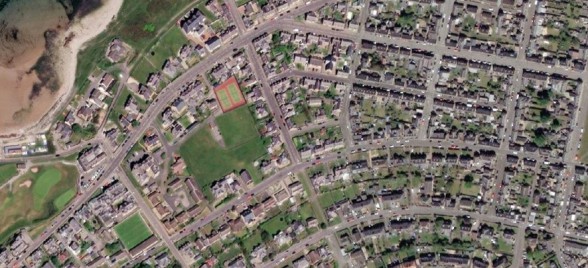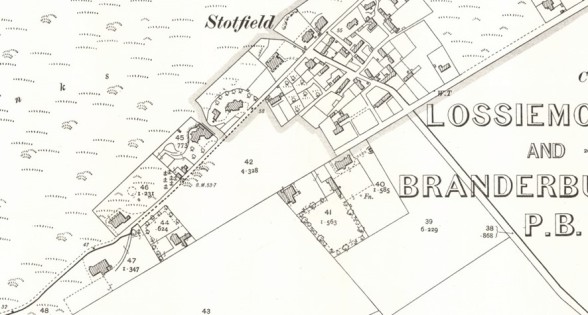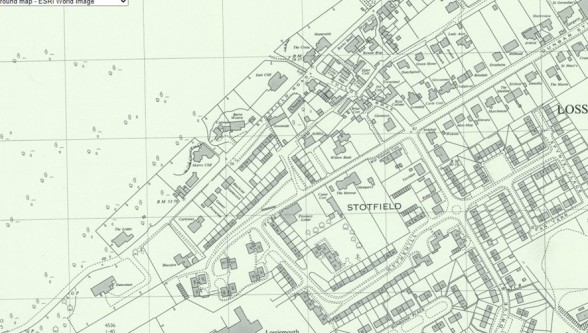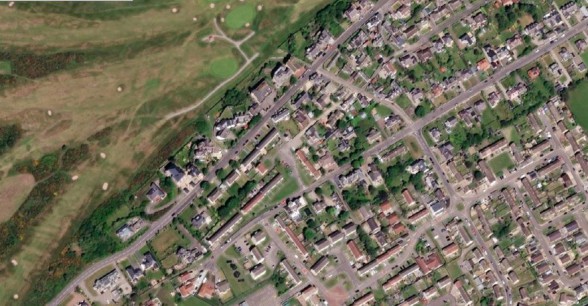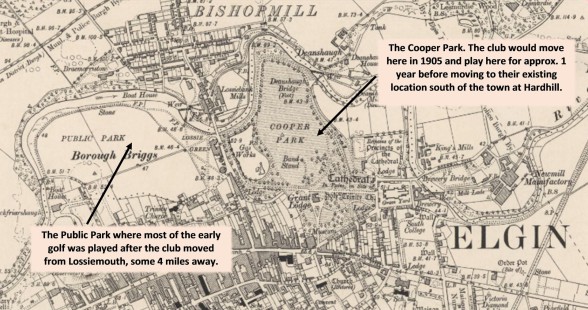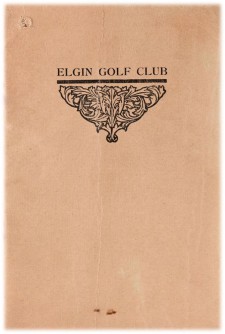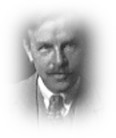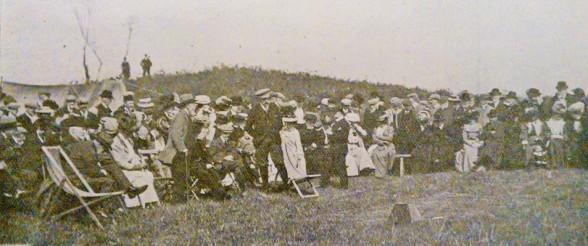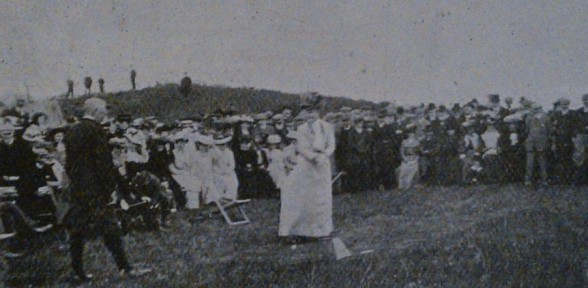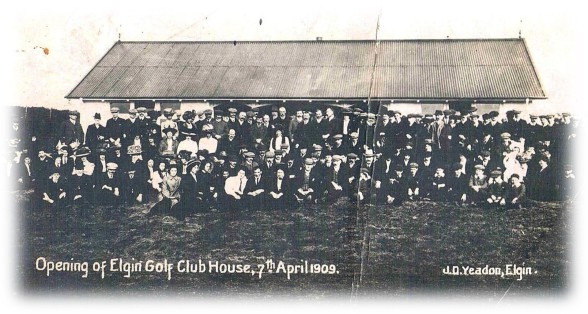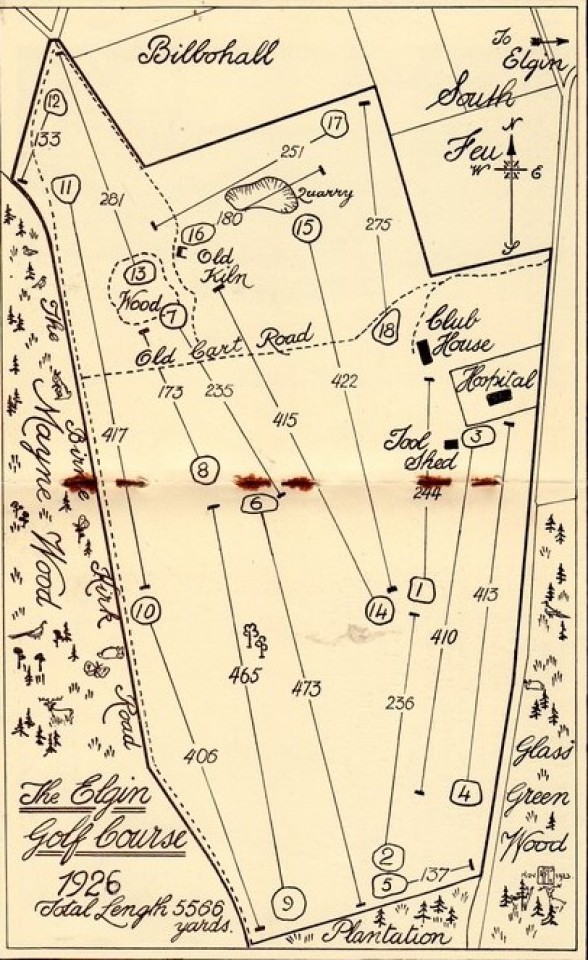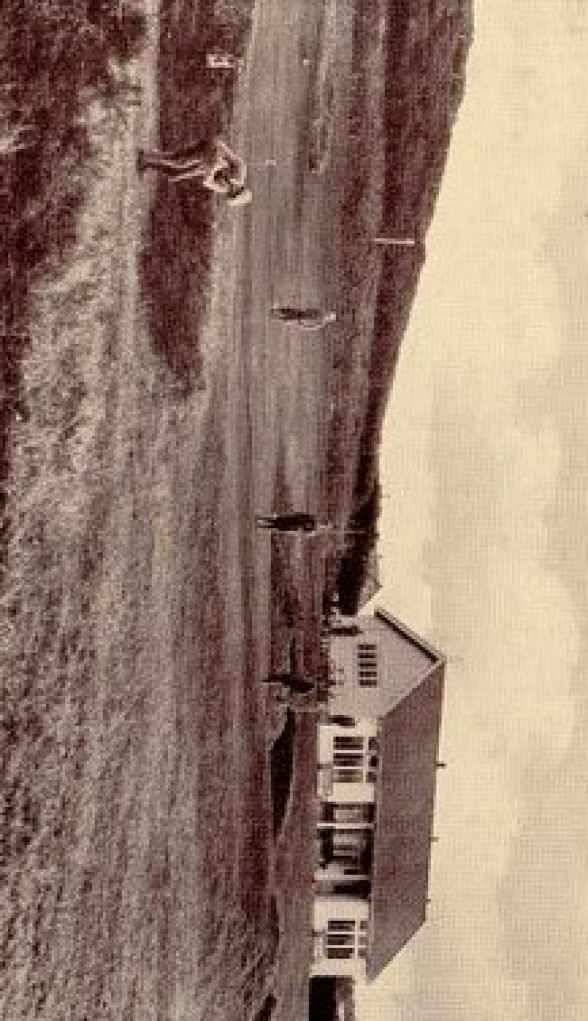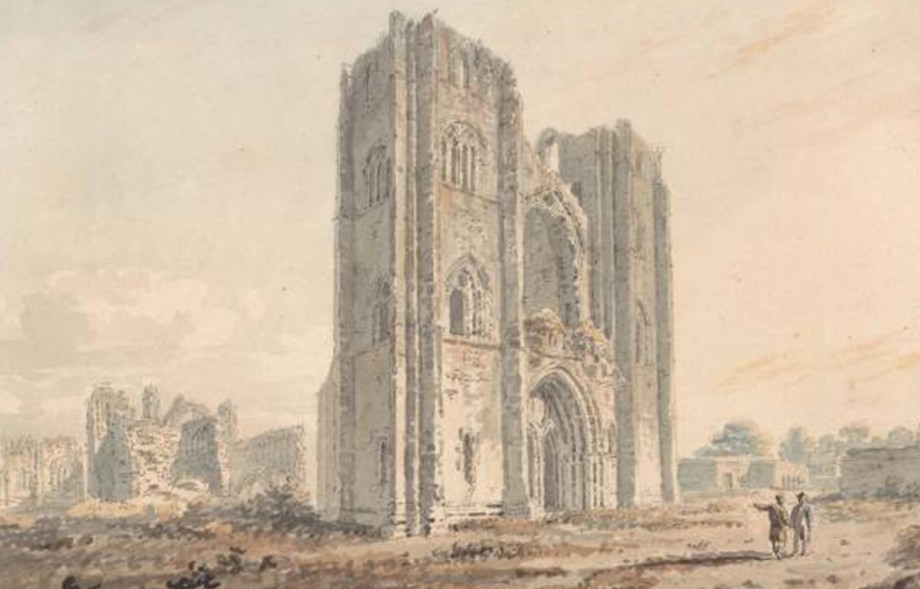
Elgin Golf Club and It’s Former Courses
Most of the following information has been researched and given to me by Doug Stewart from Morayshire and I take this opportunity to thank him for all his hard work and generosity.
The Elgin golf club have played their golf on ground at Hardhillock to the South of the town since 1906 but the purpose of our research is to highlight the club’s former courses and golf in Elgin before the club’s inception.
Early Golf In Elgin
The earliest reference – so far found – to golf being played in Elgin dates from the end of the 16th century; on 19th January 1596/97, a local goldsmith named Walter Hay was accused of playing golf (and bowls) at the time of the service:
Kirk Session Minutes
Comperit Walter Hay, goldsmith, accusit for playing at the boulis and golf upoun Sondaye in the tym of the sermon, and lies actit himselff fra this furthe vnder the paynes of fyve lib. nocht to commit the lyik outlier afoir or eftirnone the tym of the preaching.
( Translation )
Appeared, Walter Hay, goldsmith, accused of playing bowls and golf on Sunday at the time of the service, and is bound further under the pain of five pounds not to commit the like either before or after the time of the service.
Golf appears again in the Kirk Session records on 9th October 1604 when it was recorded:
Kirk Session Minutes, Elgin
It is appointed and ordaned that the actis quhilk wes maid of a lang tyme bygane anent the inhibitioun of any pastymes making on the Sabboth be publictlie intimat furth of the pulpit that nane pretend ignorance thairof.
( Translation )
It is appointed and ordained that the acts which were made a long time bygone about the inhibition of pastimes making on the Sabbath be publicly intimated from the pulpit that none pretend ignorance thereof.
Kirk Session Minutes, Elgin
Maister James Gairdin declairit that thair wer certane elderis at the golf play and on Sonday last quha haid promeisit amendment.
( Translation )
Master James Garden declared that there were certain elders at the golf on Sunday last who had promised amendment.
Meaning, of course, no Sunday golf, but the habit seems to have been hard to break, the subject of Sunday golf raised its head on 30th January 1627 when:
Kirk Session Minutes, Elgin
Goufferis on the Sabbath. Compeirit certain personis aprehendit at the gouff in tyme of divyne seruice.
( Translation )
Golfers on the Sabbath. Appeared certain persons apprehended at the golf in time of divine service.
Early in 1647, Lewis Gordon, a son of the Marquis of Huntly, had been excommunicated – which, among other things, meant no-one should speak with him. On 20th August, the Kirk Session record:
Kirk Session Minutes, Elgin
George Watson, balmaker, denyed that he spak with Luice Gordoun.
George Watson, ball maker, denied that he spoke with Lewis Gordon.
It is not certain George Watson was a golf ball maker, more likely musket balls, but the records of Elgin from 28th February 1649 state:
Town Council Minutes, Elgin
George Watson, gouffer, burges of Elgin was decernit to mak payment to Alex’r Geddes, skinner, burges ther, of four punds four s. money and that in contentatione of certain golf clubs of and recawit be him fra the said Alexander.
( Translation )
George Watson, golfer, burgess of Elgin was ordered to make payment to Alexander Geddes, skinner, burgess there, of four pounds, four shilling money and that in contention of certain golf clubs of and received by him from the said Alexander.
With a further mention of George Watson in the same records on 12th May the same year:
Town Council Minutes, Elgin
Walter Gilzeane, saidler, burges of Elgin, becam actit as cautioner souertie and law borrowis for George Watsone golf bal maker burges there that John Duncan wreight ther, his wyfe, bairnes, familie, guidis and geir salve harmles and skaithles of him and all that he may stop or let indirectlie wther ways nor be ordour of law and justice the pain of fyve hundredth pundis.
( Translation )
Walter Gilzean, saddler, burgess of Elgin, became actor as cautioner surety and law borrowings for George Watson golf ball maker, burgess there that John Duncan wright there, his wife, bairns, family, good and gear save harmless and skaithless of him and all that he may stop or let indirectly other ways nor be order of law and justice the pain of five hundred pound.
And the same records, on 7th May 1651 go on to say:
Town Council Minutes, Elgin
Captaine George Smyth was decerned to make payment to George Watsone, golfballmaker, burges of Elgin be the judges modification of four merks money.
( Translation )
Captain George Smith was ordered to make payment to George Watson, golf ball maker, burgess of Elgin by the judge’s decision of four merks money.
1833, New Year Golf
Note :-
There then seems to have been a considerable gap before the next mention of golf being played in Elgin; on 18th January 1833 the Elgin Courier reported on a game played at Gallowgreen in celebration of the New Year (old style):
Elgin Courier, 18th January 1833
New Year 1833
Saturday the 12th instant being the first day of the year, old style, a number of parties sat up the previous evening over something comfortable, for the purposes of ushering it in; and many a one seemed anxious to be the first to get a drink of the scum of the water out of the nearest well, from an idea that if they were successful in having the first draught of water after the clock struck the last hour of the past year, they would be invigorated in health, and preserved from all harm for twelvemonths to come.
A number of gentlemen met on Gallowgreen and spent the day in golfing, an exercise which we would be happy to see brought into fashion again as it was in former periods, when the good citizens of Elgin used to go to the links, a place much altered from what it was, owing to the sand on the banks of the Lossie having been loosened and drifted by the wind to such an extent as to cover up the beautiful green sward to a great depth, a proof of which was shewn about two years ago, when the workmen employed by Captain Stewart, in digging for the foundation of Lesmurdie cottage, came upon a rich soil, nearly ten feet below the surface
Note :-
The links or place where the golfers used to meet was a commonty, where all and sundry could entertain themselves and is still known by the appellation of Linksfield, a very extensive farm tenanted by Provost Lawson. A description which ties in well with the description of the game locally given by Lachlan Mackintosh in his worthy publication, Elgin Past & Present, from 1891:
( From Mackintosh;s Book )
One of the chief outdoor amusements of the burgesses of Elgin in past centuries was that of golf. In early morning and dewy eve it had been with them an abiding source of intellectual healthy rivalry. So much was this game in vogue, particularly in the seventeenth and eighteenth centuries, that it was nothing unusual for a merchant to “draw the half-door of his shop tae,” and with another like-minded wend their way to the “Links, then and for a long time allotted to this game of golf.” A large space it was, “consisting of a thousand irregular hillocks of sand, here and there intermingled with whins,” and lying, as this large space did, about equidistant from the Castle of Spynie and the City, it will be no great stretch of the imagination to suppose that the Bishop’s retainers in the Castle and those dwelling within the precinct of the Cathedral would have had many a well-fought game with the gentlemen and burgesses of the town.
The lands near the Burgh about the beginning of the eighteenth century were being recognised as valuable possessions, and the Links that had been a town’s commonty for centuries by about 1760 became the farm of Linksfield. Thereafter golf ceased to be an Elgin game until revived, with the past year or two, by the Moray Golf Club, the Lossiemouth Railway giving facilities to reach Stotfield Links, where ample space for the prosecution of this old Elgin game is available.
After those old days, the closeness with which old and young found it necessary to apply themselves to their daily tasks precluded the possibility of much time being given to outdoor amusements. Bowl-throwing along the roads at the east and west ends of the town and shinty or the “club” during crisp, frosty weather, and such like, were about the only outdoor sports engaged in, with an annual holiday walk to Lossiemouth during the Lammas tides, and, as has already been mentioned, the annual bonfires and periodic fights between the boys of one-half of the town and those of the other.
1875, Club (but no Course)
The Elgin Courant of 6th April 1875 carried an article announcing the formation of a golf club at Elgin:
Elgin Courant, 6th April 1875
Elgin – Establishment Of A Golf Club
On Friday last a meeting of gentlemen favourable to the formation of a Golf Club met within the offices of Mr Forsyth, solicitor, and, we are glad to day, established a Club. A Chairman and Vice-Chairman were appointed and also a Committee of Management to carry out affairs. A great number of gentlemen have already signified their intention to join, and the Club altogether promises to be a success.
Note :-
Good news for golfers in the town, but the course wasn’t in Elgin – it was in Lossiemouth. Another Elgin Courant article later in the year, on 2nd July 1875 gives the game away:
Elgin Courant, 2nd July 1875
Notes From Lossiemouth
Summer Visitors And Amusements
Our good town is rapidly filling up with visitors, who seem to be enjoying much the delightful weather of this very fine season. Bathers are numerous, many going into the sea and many others partonising the public baths. Rod fishing is also very popular. The piers and rocks are covered with enthusiastic votaries of the gentle art, and boats full of them can be seen far out in the bay. Golf is a new amusement here. The recently formed club seems to be thriving, if we can judge by the numbers that enjoy the game, especially on Saturdays.
Note :-
All emphasized by the report of the new club’s first annual general meeting in the 30th June 1876 edition of the Elgin Courant:
Elgin Courant, 30th June 1876
Lossiemouth
The annual general meeting of the Moray Golf Club took place at the Club-House, Stotfield, on Saturday last, when the following gentlemen were appointed office bearers for this year, viz. – President, Provost Culbard; Vice-President, Sheriff Smith. Members of Committee – Messrs Thos Yool, Coulardbank; George Todd, Ardivot; D Forsyth, solicitor; William Anderson, shipowner; and A G Sellar, Elgin. Secretary and Treasurer, Charles Clark, bank agent, Lossiemouth.
Note :-
So, a golf club for Elgin, but not a golf course for Elgin – but, then, where about in Lossiemouth was this playing area, and why do we think Moray Golf Club was founded in 1889?
The answer lies in the very first page of John McConachie’s excellent celebration of the club centenary, The Moray Golf Club at Lossiemouth, 1889-1989:
An earlier attempt to start a club, which was recorded in a minute of 2nd April 1875, ended in failure after some years, although it is known that golf was played on the open land to the east between James Street and the present clubhouse. The club which became defunct was also called the Moray Golf Club and its members played on a seven-hole course laid out at Stotfield on the ground between the houses called The Camp and Skerrycliff.
The earlier playing area, between James Street and the current clubhouse of Moray Golf Club, can be identified on the OS 25-inch, 1903 map, which shows an area of open ground exactly as described
James Street today with the old course developed with housing
A large part of this property has been lost to housing development and the extension of Kimberley Street across it, north to south. However, part of this property has been retained for recreational, including tennis, walking football and ‘footgolf’.
The land used by the new club, between The Camp and Skerrycliff, can also be easily identified on the OS 25-inch, 1903 map below as an area of open ground exactly as described.
1903 Skerrycliff & Camp
The same area 61 years later in 1964
A large part of this property has been lost to housing development, and it is likely to be the Private nine-hole course described in an advertisement below from the Aberdeen Daily Journal on 3rd March 1920:
Aberdeen Daily Journal, 3rd March 1920
Lossiemouth
Furnished House, Stotfield. Lossiemouth, over-looking Moray Firth and golf course, to be let for Easter Holidays and May, June and July. There are 14 bedrooms. Four reception rooms, including inner hall, and ample servants’ offices. Small golf course within the grounds. Apply to Mrs Paterson, Merchant, Stotfield, Lossiemouth, or to the subscribers. Allan & Black, Solicitors, Elgin.
1889, Club (but no Course)
What Mackintosh fails to tell us is, two years earlier, when the current Moray Golf Club was founded, the birth was hailed in the press as new golf club for Elgin, announced locally in the Elgin Courant of 22nd February 1889 and Forres Gazette of 6th March 1889; and, even as far away as Dundee – as evidenced by a titbit on 28th February 1889 in the Dundee Courier:
Dundee Courier, 28th February 1889
Golf Club For Elgin
A golf club is about to be formed in Elgin. A course has been got on the Links at Lossiemouth at a nominal rent from Captain Dunbar Brander of Pitgaveny.
1893, Golf in the Public Park
On the evening of Tuesday, 31st October 1893, a meeting was the in the Station Hotel – now the Laichmoray Hotel – at which a golf club for Elgin was formed, with the intention of applying to Elgin Town Council for permission to lay out a nine-hole golf course in the Public Park.
Aberdeen Journal, 3rd November 1893
New Golf Club At Elgin
Home At Last
On Tuesday evening a meeting of those desirous of forming a club for the practice of golf on the Public Park was held in the Station Hotel. An executive was appointed, and Mr Gordon, clothier, was appointed president; Mr Mair, chief constable, being secretary. Already a large number of members have joined. As soon as permission has been obtained from the Town Council to make the holes and other accessories of a golf course the work will be proceeded with.
Elgin Courant, 3rd November 1893
Driving Club
Mr Shewan, draper, on Monday evening submitted an application to the Town Council on behalf of a number of gentlemen who wished the permission of the Council to play golf in the Public Park, and, with that view, make the necessary arrangements for laying out holes and the other accessories of a golf course. The course proposed will be a short one, probably six holes. In response to a circular letter, issued by Mr J B Mair, Chief Constable, a number of gentlemen met in the Station Hotel on Tuesday evening for the purpose of forming a Driving Club to play on the Public Park. Mr Gordon, clothier, was appointed President, and Mr Mair Secretary of the Club which it was agreed to form. An Executive was appointed with power to enlist members, and already many have given in their names. When carried into effect the course on the Public Park will be a great convenience to the members of the Moray Golf Club for practicing when a spare hour which may be at their disposal would not admit of a visit to the more pretentious course at Lossiemouth. The convenience of a course adjoining Elgin so closely will also be readily admitted for golfers who wish a short round at their favourite game before breakfast.
Elgin Courant, 3rd November 1893
A Golf Course In The Public Park
A communication from Mr Shewan, draper, stating that is was desired to make a short golf course on the Public Park, and asking the authority of the Town Council to do so, was read. This matter was remitted to the Public Park Committee to inquire and report
Northern Scot, 4th November 1893
Proposed Golf Course In Elgin Public Park
A number of our local golf enthusiasts have applied to the Town Council for permission to play golf in the Public Park, and a Driving Club has been formed, with Mr Gordon, draper, as president, and Mr J B Mair as Secretary. The course would be short, but it would be convenient and healthful for members to have an airing when they could not spare time to go to Lossiemouth.
Northern Scot, 4th November 1893
Proposed Golf Course In Public Park
A letter from Mr Shewan, draper, asking that the Council authorise the making of a short golf course in the Public Park was read. It was remitted to the Public Park Committee for consideration and report.
Elgin Courant, 29th December 1893
Elgin Town Council
A minute of Parka Committee in regard to the application of the Golf Club for permission to make nine boles on the Public Park was read. The Committee recommended that permission should be granted, and to allow play up to eleven o'clock each day. They did not see their way to content to allow play on Wednesday
Northern Scot, 30th December 1893
Golf In The Public Park
A minute of Public Parks Committee in regard to the application of the Golf Club for permission to make nine holes on the Public Park was read. The Committee recommended that permission should be granted, and to allow play up to 11 o'clock a.m. each day. They did not see their way to consent to allow play on Wednesday afternoons. The report was adopted on the motion of the Provost.
Aberdeen Journal, 11th January 1894
Inauguration Of New Golf Club In Elgin
Sometime ago a golf club was formed in Elgin for the purpose of playing on the Public Park, as it was sometimes inconvenient to go Lossiemouth to play over the Links there. A course of six holes was laid out, and permission was granted by the Town Council to play from seven o’clock in the morning to eleven o’clock. The opening match took place yesterday between teams chosen by the president (Mr R Gordon) and the secretary (Mr J B Mair), and resulted in a win for the president’s team by a large majority of holes. Previous to commencing the match, Mr J B Mair, who drove off the first ball, and had been most active in promoting the club, was presented with a handsome new driver. The driver was the gift of the members of the club, and it was handed to Mr Mair by the president.
Elgin Courant, 12th January 1894
Opening Of A Golf Course At Elgin
Some time ago a number of Elgin gentlemen formed themselves into a club for the purpose of endeavouring to get a course for golf opened near Elgin, because very little practice can be got at Lossiemouth during the short day in the winter seasons. It was thought a few holes might be made in the Public Park, and an application was made to the Elgin Town Council to allow the club to make holes in the Public Park. After carefully considering the matter, the Council granted the club authority to make a short course but restricted the hours of play to be from 6 to 11 A.M. The club wished to play on Wednesday afternoons, but the Council could not see their way to grant that request. No doubt, however, after these gentlemen see how harmless the game is, they may yet see their way to allow play on the course every afternoon. On the Council granting permission to make a course the club at once set to work and made one about three-fourths of a mile long, and consisting of six holes, finally arranging to open it by a friendly game, side to be drawn by the President (Mr Robert Gordon) and the Secretary (Mr J B Mair). The opening match took place on Wednesday last, when twenty-two of the members engaged in competition, the result being a victory for the President’s team. Previous to commencing the President presented Mr J B Mair with a handsome driver from the members of the club. In doing so he said the members wished him to drive off the first ball to show how they appreciated what he had done in promoting the club, and presented him with a driver for that purpose. The course will never be like the excellent course on the Links at Lossiemouth, yet it will be a boon to lovers of golf in Elgin who cannot get a game so often as they would like to. We understand that the membership is already about sixty, and that the first general meeting is to be held in the Station Hotel on Monday first.
Scottish Referee, 12th January 1894
As a result of permission granted by the Town Council of Elgin to play golf in the public park, a short course has been laid out. 'The formal opening took place on Wednesday afternoon, when Chief-Constable Mair, who has taken a very lively interest in the promotion of the undertaking, drove off the first ball. The course is one of six holes.
Banffshire Journal, 16th January 1894
Golf Course At Elgin
A Golf Club was recently formed of number of Elgin gentlemen with the view of getting a course near Elgin on account of the distance of the Lossiemouth links from the town. The Club was successful in inducing the Town Council to allow a course to laid out on the Public Park, and the new course was formally opened on Wednesday, when twenty-two members took part in match. The course is about three-fourths of a mile long, and consists of six holes, and will doubtless prove a boon to lovers of the game in Elgin, who cannot go to Lossiemouth so often they might wish.
Forres Gazette, 17th January 1894
Golf Course At Elgin
A Golf Club was recently formed by a number of Elgin gentlemen with a view of getting a course near Elgin on account of the distance of the Lossiemouth links from the town. The Club was successful in inducing the Town Council to allow a new course to be laid out in the Public Park, and the new course was formally opened on Wednesday when twenty-two members took part in a match. The course is about three-fourths of a mile long, and consists of six holes, and will doubtless prove a boon to lovers of the game in Elgin who cannot go to Lossiemouth so often as they might wish.
Elgin Courant, 20th March 1894
LOSSIE GREEN GOLF CLUB, TO THE EDITOR
Sir, I ask for the publicity your paper can give, in the belief that this letter will be read by many who, like myself, have been groping around looking for the why and the wherefore of the restrictions placed on the playing of golf on the Public Park by our city fathers. But, in the first place, I would like again made plain to me the purpose for which the town acquired the park. Did the Councillors see with the mind's eye the Lossie deepened and a great water-way, with warehouses and wharfs lining its banks, and ships of all nations on its bosom; while in their ears sounded the tumult and noise of the labour of myriads of wage slaves? And did they also in their dreams see these same toilers after the brunt of the day's fight move aside from the busy thoroughfares and wander through the beautiful park, with here a plashing fountain and there a shady nook, where they rested awhile and thanked God and Dean of Guild Scott for the privilege of enjoying a breath of pure air at £50 a year. 'Tis a pretty picture and Poet Ogilvie should make a good thing of it: I give the tip free. But to some us this was not the object of the park's being acquired; but that it was distinctly bargained for on the understanding that it was to be used as a recreation ground, there being for many years not one suitable place in all Elgin where our young men could enjoy the many games it is good for youth to indulge in.
Be that as it may, for such a cramped and densely-populated town as Elgin is, a “lung” was urgently required, and has been taken the utmost advantage of by all classes; in fact, the park is already Elgin's fashion-place. Straying along the banks of the river on an evening in summer-time, you may see cricket, football, quoiting, &c., in full swing, the players thoroughly enjoying the healthy outdoor exercise; and if you get up with the lav'rock you may see the ardent disciples golf, with dignified mien, intent on their favourite game. But, alas, if they do not rise at early dawn they may let their good clubs rust, for is it not set down in the Elgin Council statutebook that ye game of golf must not be played on the Public Park after eleven of the clock morning for fear of hurt to the lieges, their wives, bairns, and nursemaids. For, at that hour a mighty concourse of maids and perambulators flood all the park and river banks, rendering it very unsafe for unprotected males to walk about, far less play golf. But everything has been done which forethought and experience could do, and the timid are reassured when they read on signposts erected at short intervals (done by contract), “Keep to the Right,” “Beware of Pickpockets,” “Don't Wink at the Policeman,” “Don't Molest the Worms,” &c., &c.
Now, Sir, I have my doubts as to the truth of the statement that the Council recommended that the golfers should wear rubber-soled shoes for fear of injury to the turf, but I do know that they have prohibited them from playing after eleven o'clock in the morning. And, as a golfer, and one who has to get into harness for the day's work by eight a.m., I would like if some one would kindly reply to this letter and inform me how the difficulties I have mentioned can be got over, so that I could get a game in the afternoon. I am not selfish; I wish to see all people get the most benefit they can out of the boon of the Public Park, or public swamp, whatever it may be. On Wednesdays we have our half-holiday, and with cheap fares could go to Lossiemouth; the other members of our club, who get the half day on Saturday, could go there on that day. Can nothing be done to open the park for us golfers on the other afternoons of the week? The time hasn't come to ask the Council for leave to play on Sunday yet, though I am sure, from the generous manner in which the Lossie Green Golf Club have been already met by the Town Council, that, too, has merely to be mooted to be granted. We golfers are too modest, I fear; we don't ask enough. I am, Sir, yours, Tee.
Elgin Courant, 27th March 1894
ELGIN PUBLIC PARK, TO THE EDITOR
Sir, Can you tell me what objection the Town Council has to golf playing in the Public Park at any hour? Why should it be only from seven a.m. to eleven a.m? The park is surely not so crowded with people to make playing dangerous. If I understand aright, the park was acquired for the very purpose of giving the people of Elgin ample scope for amusement and game,. To leave out Wednesday and Saturday for the cricketers and football players, what earthly objection can the Town Council have to golf being played on the remaining days? It appears, to say the least of it, rather arbitrary. Can you, Mr Editor, do nothing in the matter? I am, Sir, yours , &c., GOLFER
Elgin Courant, 10th April 1894
TO THE EDITOR
Sat,—Our worthy Provost is well known as a keen bowler; and many more of our Magistrates and Councillors have some pet pastime or other. To a few of them out-door games will doubtless appear altogether too frivolous, and beneath their dignity. The framers of the restrictions on golf playing on the Public Park have been narrow. But surely those among our Councillors who have experienced the pleasures, each of their particular pastime, will do all in their power to satisfy the demands of the large number of golfers now in Elgin, and which were rightly stated by “Tee” and “Golfer” in the Courant to be to the hurt of no one.
I have not infrequently of late made a point of walking round the Lossie banks past the park, and that, usually, after eleven o'clock - the golfers' utmost limit. Of the many times I have taken this path I cannot speak of seeing since this year began six people at once on the park. This will be altered with the longer and milder day, I am sure; but, even then, it is only twice a week the park gets a sprinkling of health-seekers, viz., Wednesday and Saturday, and these days, it has been pointed out, could be reserved exclusively for cricket and other games. By the bye, it may be mentioned that some of the cricketers have goy inoculated with the golf craze, and as they have experience of the new course, they could tell, through your paper, how far the present arrangement of the holes would interfere, if at all, with cricket playing. That it would interfere with mere pedestrianism is all nonsense, as (leaving all the other beautiful walks out of count) the town possesses an estate over which the people get free access which contains within its bounds nearly as pretty “bits” of wood and water , hill and haugh, as are to be found in all fair Moray. And for the people who delight in these walks, the Public Park will never offer any equivalent; the most they could get there at any time is wet feet.
Another thing that ought not to be lost sight of by those in authority is the fact that, where business men and men of means and leisure go to spend their holidays is now more than ever the place where they can get a game of golf. Elgin, with all its advantages of lovely scenery and historical interest, is notoriously behind places of less importance. I may mention Forres and Nairn. The climate of those places is not superior to that of Elgin, but they have not lacked in judicious advertising and careful nursing, with the result that people go there to spend their money and enjoy themselves, and everyone is benefited. An Amenity Association, which owed its birth to our worthy Sheriff-Substitute, has done something; but I am afraid they were never properly supported by those whose duty ought to have made them work on the same lines. I would say to our council - and my authority is similar success elsewhere - do nothing to stifle the playing of golf in Elgin. They were generous enough to give a gold medal to be played for over the Lossiemouth Links, and every one here knows the benefit to Stotfield and all round which has followed the success of the Moray Golf Club. Elgin can never compete certainly with Lossiemouth in golfing advantages, but we ought to make the most, not the least, of what ground we have.
Elgin has been asleep, and allowed much to pass that would have made for her benefit. The insertion of this letter to your many readers will, I trust, help a little to her awakening.—l am, Sir, yours, &c., Market Green. Elgin 5th April,1894.
The ‘playground’ for the residents of the town of Elgin was the Public Park (an area now known as Borough Briggs (and Lossie Green) most of which was acquired from the Seafield family in 1888. They would eventually move to the Cooper Park in 1903.
The matter of restrictions to play on the Park was not considered by the Town Council until their final meeting of the year, late in December. The Northern Scot of 30th December reported the Committee recommended permission should be granted, and to allow play up to 11am each day. They did not see their way to consent to allow play on Wednesday afternoons.
On permission being granted, the members lost no time in layout their new course, limiting themselves to but six holes – rather than the nine proposed – of combined length something in the region of ¾ mile. The opening match – the President’s team against one chosen by the Secretary – took place on Wednesday, 10th January 1894. The Elgin Courant of 12th January, on reporting the event, declared, “the membership is already about sixty, and the first general meeting is to be held in the Station Hotel on Monday first.”
Elgin Courant, 1st May 1894
Elgin Town Council
The monthly meeting of the Elgin Town Council was held last evening - Provost Law presiding. A petition signed by seventy-five ratepayers, setting forth that the hours of playing golf on Public Park were found unsuitable, and praying that the Council should withdraw the present regulation and allow the game to be played at all times, except on Wednesday and Saturday afternoons, was submitted. Messrs C. D. Wilson, jeweller; monies Christie, Station Hotel; F. Davie, gunmaker; and Gordon (of Gordon & Greenstreet, tailors), appeared in support of the petition. Mr C. D. Wilson briefly addressed the Council. Bailie Grant remarked that, if the members of the Golf Club made up for any loss that might arise through any depreciation of the letting valve of the Park, he would agree at once to the petition, otherwise he would not consent. The matter was left over for consideration.
Aberdeen Journal, 1st May 1894
Town Council
The monthly meeting of Elgin Town Council was held yesterday evening – Provost Law presiding. A petition signed by 75 citizens was read asking leave to play golf at all hours in the Public Park except on Wednesday and Saturday. A deputation appeared in support of the petition. It was referred to the Park Committee to consider and report.
Elgin Courant, 29th May 1894
ELGIN TOWN COUNCIL
GOLF ON THE PUBLIC PARK
The Clerk read a minute of meeting of the Public Park Committee, present—Dean of Guild Gibson (Convener), Councillors H M S Mackay, Watson, Adams, and Jeans, at which a petition presented, numerously signed, asking that the Council allow the game of golf to be played on the Public Park on all lawful days with the exception of Wednesday and Saturday afternoons. The Committee divided on the subject, when the Convener and Councillor Mackay voted against the petition, and Councillors Watson, Adams, and Jeans in favour of it. It was thus agreed to recommend that the petition be granted. It was also recommended that the park be let to the Morayshire Farmer Club for their annual show on same terms as formerly, and to approach Mr Gregory, Maryhill, with the view of acquiring the Lossie Banks on his property.
Councillor Watson, in moving the adoption of the Committees report, said that at present there were many more dangerous games than golf played in the Public Park. There seemed to be an idea that golf was an extraordinary dangerous game, not only for players but for the general public; but he thought he was perfectly safe in saying that, for every one that was injured in playing golf, there were half-a-dozen injured in playing cricket or football. He did not wish to say one word against either of these games, but his contention was that they were much more dangerous than golf, and be could not see why there should be any restriction placed upon the playing of that game. Another objection was that it would interfere with the letting of the park, but he thought any one looking at the golf course as it at present existed would at once see that there would be no danger of that. Indeed, golf playing did not cut up the park so much as football.
Councillor Adam, in seconding, said seemingly the only objection against the playing of golf was that it was dangerous. He could assure the members of the Council that it was not a dangerous game; it was not so dangerous as cricket. They played golf calmly, and were able to see any one in front of them, and warn them if there was any danger. If there was any real danger, there would be nobody more against giving permission than he would, but he knew this idea was a perfect bogie. There was plenty of room for all the games, and when they looked at the names on the petition, he did not think they could get over it.
Councillor H M S Mackay said he objected to the Public Park being given over to a section of the public for this particular game. For one thing, he did not consider it was a good golf course, and the banks were frequented by ladies and children, and, according to his light, these would be subjected to interference and possibly to danger. Assure him that that was not the case, and his views might be altered, but at present that was the view he took of it. These were the reasons that prompted him to support the view that the petition lie on the table. He thought the golfers should be content with the privileges the Town Council had agreed to grant them when they gave them the park for the hours they had first stipulated.
The Chairman seconded Mr Mackay's motion. He was sure every gentleman around that table had an equal desire to meet the petition that might come from any section of the community, but they must keep in view with regard to the Public Park that they had a burden upon them of a very large feu-duty, and if they agreed to this petition he was of opinion that there would be a serious diminution in the revenue from the Park. If they were prepared to guarantee any decrease in the rent they got his objection would be much removed, but, as the matter stood, they would have to put their hands in their pockets for a section of the community, and not for the whole people of Elgin.
Councillor Jeans said cricketers and footballers were as much a section of the community as golfers, and he did not think there was any golf ball got on to the Lossie banks. It was a thoroughly enjoyable and innocent game, and much less dangerous than football and cricket. If the Council granted this petition there would be a large section of the public that would take advantage of the game, and he was sure it would become very popular in Elgin. He understood the park was to be used for games and not for grazing (laughter). If it was a park for grazing cattle and sheep he would understand their remark, but he understood it for the games of the citizens and. therefore, he thought there was no better game than the game of golf.
Bailie Duff said that although the danger might not be great there was a danger; and with regard to cricket and football, they were confined to a small area, so that there was no danger to the public.
Councillor Anderson said that cricket and football might be dangerous to the players, but it was not dangerous to the public.
Councillor George Mackay said he was neither a cricket, golf, or football player, but he did not see how they could set their faces against a petition signed by such a large section of the community. He had walked round the banks when the golfers were playing, but he had never seen a ball going without the bounds allotted to the Club.
Bailie Gray said that it was a dangerous game to those walking near where it was played. He had seen himself accidents taking place on the Stotfield links. He had seen a nursemaid struck down with a golf ball on the links, and also a dog, while he himself had been struck by a ball. He could assure them it was a very dangerous game.
Councillor Ramsay said that the petition was not for the benefit of the community whom they represented, and they did not represent any one section of the community.
Dean of Guild Gibson said if the hours were extended the game would get more popular, and, consequently, there would not be so much room for the recreation of the young folks, who had, from the restriction of the Market Green, their recreation ground much reduced. Therefore the park would be more crowded on certain parts of the day, and the danger from playing golf to them might be increased. In view of that, he would approve of the hours being restricted to what they were at present.
Councillor Watson, in replying, said he was at one with those who said that the park was originally acquired for the purposes of games. Now, golf was the most popular game in Scotland, and he did not see why it should be tabooed. He himself had been knocked down by a cricket ball, and could say that any one receiving a knock from a cricket ball and golf ball would be able to recognise the weight of the former. He thought he would be a very “green” player indeed who would drive a ball on the banks of the Lossie, as the course was now arranged.
A division was then taken, when there voted for Councillor Watson's motion the mover and seconder—2; and for the amendment—Bailies, Grant, Duff, Young and Gray, Dean of Guild Gibson, Councillors H M S Mackay, Ramsay, Young, Leslie, and Anderson. Treasurer Christie and Councillor Jeans and Geo Mackay declined to vote.
The amendment therefore became the finding of the meeting.
Aberdeen Journal, 29th May 1894
Town Council
The Council refused permission to golfers to play in the public parks beyond the present restrictive hours.
Note :- The above situation was common place in Scotland in the mid 1800s, where golfers were playing their golf on Public areas and Parks. Council’s in Aberdeen, Glasgow, and Leith were all imposing the same restrictions on golfers due to public safety.
Councillor H M S Mackay moved that the petition lie on the table. He did not approve of the Public Park being given over to a section of the public for this particular game. For one thing, he did not consider this was a good golf course, and besides the banks of the river surrounding the course were frequented by ladies and children, who, according to his light, would be subjected to interference or possible danger if golf was played there at all times. Assure him that such would not be the case, then his views might be altered. He thought the golfers should have been content with the privileges which the Town Council had already conceded to them to use the park for certain stipulated hours.
The Chairman seconded Mr Mackay's motion. In doing so, he might say he was sure every gentleman round the table had an equal desire to meet any petitions that might come from any section of the community, but that they must keep in view with regard to the Public Park that they had a burden upon them of a very large feu-duty, and if they agreed to this petition he was of opinion that there would be a serious diminution of the revenue from the park. If the petitioners were prepared to guarantee to make up any decrease in the rent they got, his objection would be much removed, but as the matter stood now not only would the safety of the public be impaired, but they would have to put their hands in their pockets for a section of the community and not for the people at large.
Councillor Jeans said that as a golfer he took exception to the remarks which had fallen from the last two speakers about the petitioners being a section of the community. Golfers were no more a section of the community then cricketers or footballers. As to the argument about danger, he would just say that there was no danger whatever to people walking along the banks, and before they played a ball they saw and warned anyone in front of them. The game was a thoroughly enjoyable and innocent one and the Council granted the prayer of the petition, he was sure that a very large section of the public would take part in the game. He understood the part was to be used for games and not for grazing. [Laughter] If it was a field for grazing cattle or sheep, then he could understand the remarks of his friends; but he understood that the Public Park of Elgin was for the games of the citizens.
Bailie Duff said this was not a golf course, and was not suitable for a golf course. The park was devoted to games, but cricket had its portion and football its portion, while with golf, while danger might not be great, it went round and round the whole park.
Councillor G Mackay spoke in favour of the petition, while Bailie Gray, Dean of Guild Gibson, Councillors Anderson and Ramsay brought forward arguments against the playing of golf at all times and to the danger of the public, to which Councillor Watson made reply.
On the vote being taken, only the mover and seconder voted for Councillor Watson's motion, while the other two councillors who had spoken in support of it declined to vote, as also Treasurer Christie, who said he never saw the game played, and could not give any verdict upon it. By a large majority, therefore, the petition was dismissed.
The Golfers Keep Trying
Another petition was presented to the Town Council – signed by 75 of the club members – asking permission to play golf at all hours in the Public Park. This request was submitted in April, and although considered in the monthly meeting, any decision was deferred, with the request being referred to the Park Committee to consider and report. This sub-committee were divided on the matter, so the petition returned to full Council for the June meeting – at which the request was declined.
Arguments had been made in allowing the extension of the hours because there was no restriction placed on the cricket or football, with one Councillor saying “it was a perfect bogey all this talk about golf being dangerous” (pun probably not intended); against this was set the risk, the banks of the river surrounding the course were frequented by ladies and children, who would be subjected to interference or possible danger if golf was played at all times.
On the vote being taken, only the proposer and seconder voted in favour of the petition, and three members abstained – by a large majority, therefore, the petition was dismissed.
Northern Scot, 2nd June 1894
Is The Royal & Ancient Game Dangerous ?
The Public Park Committee reported having had under consideration a petition signed by some seventy-five citizens, craving for permission to play golf on the Public Park on all lawful days with the exception of Wednesday and Saturday afternoons. The committee divided on the subject, when Councillors Watson, Adams, and Jeans voted in support of the petition, and the Convenor (Dean of Guild, Gibson) and Councillor H M S Mackay against it. The committee therefore agreed to recommend that the prayer of the petition be granted.
Councillor Watson, in moving adoption of the committee's report, said he could not see why there should be any restriction placed upon the playing of golf when there was no restriction placed upon cricket or football, which, in his opinion, were more dangerous games. There seemed to be a most extraordinary idea abroad that golf was a very dangerous game, not only for players, but for the general public, but he thought he was safe in saying for every one that was injured in playing golf there were half-a-dozen injured in playing cricket or football. Another objection was that golf would cut up the park and thereby interfere with the letting value of it, but he thought that anyone looking at the golf course there would at once see that there would be no danger of that. The mere walking over the park which golf required did not cut it up so much as football did.
Councillor Adams seconded the motion, and said it was a perfect bogey all this talk about golf being dangerous. There was plenty of room in this park - 25 acres of ground - for the playing of golf and the other games, and when they looked at the names on the petition, he did not see how they could get over it.
Note :-
It would seem golf in Elgin was, at least, being talked about in the latter part of 1894 but because of the council’s constant indecision on restrictions and safety etc, it is not known how much longer the club survived. The attitude of the Town Council probably ended golf in Elgin for more than a decade.
Ten Years Later
In 1905
Golf in the Cooper Park
In 1903, and with the opening up of the Cooper Park, thoughts of some people turned again to playing the game of golf in the town; “E S H” (E S Harrison) wrote to the Northern Scot; his letter published on 16th June 1905 proposing the layout of a short course of nine or twelve holes, which could be easily made so as to interfere with nothing. It would not be necessary to cross any of the main roads, to interfere with the pitches, nor round the bandstand – an interesting immovable obstruction!
Note :- The above Mr E.S. Harrison produced a 26 page handbook on Elgin Golf Club in 1926 which I believe has been digitised by the club. It would appear that Mr Harrison was an influential member of the club.
Elgin Courant, 16th June 1905
Golf In The Cooper Park
To the Editor
21 Institution Road
Sir, Newcomers often feel a want in a place where the regular residents, through long habit, do not. In the role of a comparatively newcomer to Elgin, it has struck me as a singular want not to have at least a small golf course in the town. We have a most excellent park, a large part of which is not yet at present utilised. Why not lay down a short iron-club course there? A short course of nine or twelve holes, ranging from 70-150 yards, could very easily be made, with no crossing, and also could be easily made so as to interfere with nothing. It would not be necessary to cross any of the main roads, to interfere with the pitches, nor with an ample margin round the bandstand; neither need the part to the south of the main road be touched. This, of course, would leave all the children's part intact.
It might be objected that this would damage the Moray Golf Club, but, as a member of it, I do not see that the two would clash at all; in fact, by perhaps rousing keener interest in the game, the short course might cause more people eventually to join the senior body.
It would hardly be fair or practical to ask the Council to lay this out and tax the city for the benefit of the golfing few, though, of course, the principle was admitted when the bowling green was laid out, so I would suggest the formation of a club which would form the course and keep the greens on the same footing as the Royal and Ancient and most of the big courses of the country. That is, they pay nothing for the ground, and in turn the general public has the free use of the green. It would perhaps be advisable to charge 1d or 2d a round for non-members. To make the club as wide-reaching as possible, the policy adopted by a Border Club, of which I was a member, might be suitable, namely:- Three categories of membership - Full Members who pay, say, £1 1s entry money and subscription; working-men members who pay 10s and 10s, and lastly, apprentices - including all boys and girls - who pay 5s and no entry money. The above are merely an illustration, and probably too heavy. The requirements would be a cutting machine, a roller, and a horse, with a man; or perhaps a man and a boy and no horse. The town might, perhaps, subsidise the man, or the club might subsidise one of the town's staff. The town might perhaps permit the club to build a little tool house, or let the machine, etc., be kept in the park tool shed. Possibly a room in the library could eventually be hired for a club-room for keeping the clubs and other things. I only mention these details to show that the scheme would not involve much expense or a big capital outlay, and that started by two or three influential golfers, and with the co-operation of the Council and Parks Committee, that it could very promptly and easily be carried into execution. There is little doubt in my mind that, especially on summer evenings, a great many people who do not care or cannot get away early enough to run down to Lossiemouth for a round on the big course would have a round or two in the park. It would also be quite an important little addition to the rather sparse amusements for the summer visitors.
Trusting that you will consider this suggestion of sufficient interest to insert in your paper.
I am, Sir, yours, etc.
E.S.H.
Note :-
On 26th January 1906, the Aberdeen Journal may have been the first to broadcast the news of plans for a ‘Proposed Golf Course for Elgin’:
Aberdeen Journal, 26th January 1906
Proposed Golf Course For Elgin
There is a prospect of a nine-hole golf course being established at Elgin at an early date. The ground suggested for the course consists, in the main, of the farm of South Feu, in the occupation of Mr Isaac Williamson, and belonging to the Incorporated Trades of Elgin, with the addition of a portion of Springfield. When it became known that Mr Williamson was desirous of leaving the farm, many gentlemen were of opinion that an attempt should be made to form a golf course on the land. The ground has been carefully gone over by gentlemen thoroughly competent to judge, and they reported that by acquiring the piece of the Springfield estate adjoining South Feu, a suitable nine-hole course could be got. Steps have been taken to raise funds, and a large number of prominent citizens have pledged themselves to become original members, the one condition being the ground is acquired at a reasonable figure. There are many golf players in Elgin who would eagerly welcome this course, and it is hoped the promoters will succeed in bringing their proposal to a successful issue..
Note :-
The article talked about the establishment of a nine-hole course on South Feu, the property of the Incorporated Trades of Elgin, which was about to become vacant because the then tenant, Mr Williamson, was desirous of leaving the farm.
The ground had already been ‘gone over by gentlemen thoroughly competent to judge’ and, with the addition of the part of Springfield estate adjoining South Feu, a ‘suitable nine-hole course could be got’.
Note :-
Whether the instigators of the plans were ready or not, and negotiations were still under way with the Incorporated Trades, a public meeting was called for Thursday, 15th February, at 8pm, in the Burgh Court-House, and reported in the Aberdeen Journal of the next day:
Aberdeen Journal, 16th February 1906
Golf Course For Elgin
A meeting of those favourable to the formation of a golf club for Elgin was held in the Burgh Court-House, Elgin, last night. There was a large attendance, presided over by Lord Provost Christie, who called on Mr Mair, the chief constable to make a statement.
Mr Mair said the Incorporated Trades had a farm about to become vacant, the tenant of South Feu wishing to relinquish the lease in order to go abroad. The farm was convenient, but rather small, and two fields on the neighbouring farm of Springfield would be necessary. The Incorporated Trades wanted £50 rent for South Feu, and the two fields on Springfield, which could only be had from year to year, would bring the total to £70. Other ground was looked for, and the farm of Hardhillock was thought suitable. It extended to 54 acres, and the rent was fixed by Mr Wink, the proprietor, at £20 per annum. The expenses in connection with the formation of a club would come to £500. The annual outlay would be £70 for wages, £25 for rent and taxes, £15 miscellaneous – total £110. Calculating at 250 members and 10s 6d would be about £130, box rents £15, making a total of £145.
Mr Falconer, baker, moved – That this meeting resolves to form a golf club, called the Elgin Golf Club to be open to ladies and gentlemen.
This was agreed to, as also was a motion my Mr J Gordon, merchant, fixing the annual subscription at 10s 6d.
On the motion of Mr J Fraser, Caledonian Bank, the following committee was appointed – Messrs Mair, Falconer, R Thomson, J Clunas, R B Pratt, Gordon, T P Fraser, J Fraser, J Adams, Bailie Davie, James Bryce, Thomson, Glass Green, Harrison, Newmill, with H Savage as clerk..
At the meeting, the original plan to lease South Feu and two fields of the Springfield estate were abandoned, for reasons of cost, in favour of the farm of Hardhillock which the proprietor, Mr Wink of Mayne, offered at only £20 per annum.
One attendee, Mr Falconer, baker, moved the meeting resolve to form a golf club, called the Elgin Golf Club and – importantly, and unusually for the time – to be open to ladies and gentlemen, which was carried.
Another public meeting was held on the last Monday of February, reported fully two days’ later:
Aberdeen Journal, 28th February 1906
Elgin Golf Club – A Promising Start
A meeting of the members of the lately formed Elgin Golf Club and of others interested was held in the Burgh Courthouse on Monday evening. There was a large attendance. On the motion of Mr John Adams, Stafford House, Mr J B Mair was called on to preside.
The Secretary (Mr Henry Savege, solicitor) read a report by a sub-committee in regard to the course, which stated that a lease of Hardhillock had been secured at a rent of £20, and that all arrangements had been made in regard to taking over the place from the present tenant. The constitution and rules of the club were then read by the secretary. They provide that the governing body should consist of a captain, vice-captain, a secretary, a treasurer, and ten members of council. The annual subscription for gentlemen will be 10s 6d yearly; for ladies, 7s 6d; and for children under the age of 16, 5s. The fee for gentlemen life members will be £1 10s; and for lady life members, £7 7s. On the motion of Mr T Petrie Fraser, solicitor, seconded by Mr Thomson, the rules were adopted.
Mr James Falconer, baker, proposed that they ask Mr Mair to accept the first captaincy of the club. (Applause) It was of the greatest importance that the club should have a man of experience and tact in this position, and he was sure that in both these aspects there was no man more fitted to be their captain than Mr Mair was. (Applause) They all knew how interested Mr Mair was in all that pertained to the welfare of the young people of Elgin. (Applause) With regard to their Golf Club Mr Mair had done an immense amount of work, and had put himself to a great deal of trouble and worry over it. Without his services they would not have been so far forward as they were. (Applause)
Mr Savege seconded, and the motion was carried with acclamation.
Mr Mair thanked the members for the honour they had done him. He had pleasure in accepting the captaincy. (Applause) Nothing on his part, he promised, would be wanting, and, with the assistance of his council and other officials, he hoped they would make the course one of the best in the north. (Applause)
On the motion of Mr Mair, seconded by Mr James Gordon, Mr James Clunas, merchant, was appointed vice-captain. Mr Savege was appointed hon. secretary, and Mr J M Fraser, Caledonian Bank, hon. treasurer.
The following council, consisting of gentlemen who had been interested in the proposal, and had given their aid to it from its initiation, was appointed on the motion of Mr J M Fraser: Messrs Thomson, ironmonger; James Falconer; James Gordon; Thomson, Glassgreen; Pratt, architect; T P Fraser; Harrison; James Bryce LR; Mackintosh, tween merchant; and D Skinner, wine merchant. Messrs W Grant, solicitor, and John Hunter, bank agent, were appointed auditors.
It was agreed that only those who had joined the club and paid their subscription by the 31st March should rank as original members. Some discussion, initiated by Mr H B Mackintosh, took place on the advisability of making the course an 18-hole one. The objection to a 9-hole course was that it might become too rapidly overcrowded. Mr Mackintosh suggested that, by taking in South Feu, the course might be made one of full length. The Chairman pointed to the additional expense that would be incurred by making the course an 18-hole one, while the expense of upkeep would be much greater. The subject then dropped. The membership already amounts to close on 200, and names are rapidly being added to the list being prepared by the secretary.
At this meeting, it was announced about 200 persons of both sexes had applied for membership. Also at the meeting, the first constitution and rules for the club were approved; subscriptions set as gentlemen 10/6, ladies 7/6, juveniles under sixteen 5/-.; and, the first set of officials formally appointed – Mr Mair, captain; Mr James Clunas, draper, vice-captain; Mr H Savege, secretary; and Mr J M Fraser, treasurer.
Aberdeen Journal May 9th 1907
Elgin Golf Club
-----------------
Opening Of The Course
The nine hole golf course laid out by the Elgin Golf Club at Mayne, a little over a mile from Elgin, was formally opened yesterday afternoon in splendid weather in presence of a large company of spectators. The event was looked forward to with much interest especially by those golfers to whom the splendid course of the Moray club at Lossiemouth is, for various reasons, barred, and who naturally desired a golf course at their own doors. A number of seats were arranged around the first tee, and here the company including, many ladies, gathered to hear the speeches.
Lord Provost Christie said the golf course was the newest attraction to their good city. They needed open air exercises, and what better exercise could they get than golf ?.
There was saying that “ all work and no play made Jack a dull boy” but Jack had taken the matter into his own hands and provided his own games, which were all, or nearly all, outdoor. As they grew older there were other sports, such as curling and bowling, that could be enjoyed, but both had the disadvantage of being played by only one sex. That, he thought, was a mistake. There was no reason why ladies should not play bowls for instance. Lawn Tennis also had the disadvantage of requiring more activity than older people possessed, but golf was suitable for all, young and old, and of both sexes – ( applause ) – and it could be played practically all the year round.
The difficulty of getting a suitable course near the town had been felt for years, but given the enthusiasm of a man like Mr Mair, and the help of a public spirited proprietor like Mr Wink of Mayne, and their difficulties were solved, the mountains were soon reduced to mole hills, and the present course formed. ( applause ).
Mr J.B. Mair said that the desire for a golf course for Elgin became very acute some two years ago, and several site were looked at.
Some 15 months ago the present site had been discovered and they were indebted to the proprietor, Mr Wink, for the manner in which he had met them. He thought they had secured a lease of the parks on very favourable terms. Mr Mair referred to the difficulties encountered by the club in taking over and laying out the ground. Almost every member of the committee had a plan of his own, and the course was ultimately laid out by Mr Alexander McHardy of Inverness. They had expended almost £500.
There were 237 original members and the membership now amounted to about 350 ( Applause ). He begged to introduce Mrs Wink, and asked her to drive off the first ball ( Applause ).
Mrs Wink gracefully complied amid cheers. Mr E.S. Harrison, vice captain of the club, moved a vote of thanks to Mrs Wink. ( Applause )
Mr John Wink briefly acknowledged the compliment.
The following are the lengths of the holes :- 1, 235 yards, 2, 224 yards, 3, 433 yards, 4, 212 yards, 5, 154 yards, 6, 290 yards, 7, 145 yards, 8, 185 yards, 9, 285 yards. Several of the holes lie in the boundaries of the course, and the reckless player is punished by getting out of bounds.
Mrs Wink Preparing to Hit The First Shot and Open The Course
Elgin Courant, 15th June 1906
Elgin Golf Course
By
Doug Stewart
The Elgin Golf Club, whose formation we have already recorded in our columns, has been exemplary energetic in carrying out their arrangements, in leasing suitable ground in laying out the course. The work of laying out is nearing completion. This does not, of course, imply that play can forthwith be begun upon it. Some of the fields have to be re-sown with grass to allow the whole course to be well consolidated. Member will most likely abstain from playing on it till next spring. The idea of getting a course in the immediate neighbourhood of Elgin was first thought of when it was ascertained that Mr Williamson was anxious to get clear of the farm of South Feu. The ground was examined by the promoters with view of suggesting the possibility of making a whole course on the ground, but it was found that South Feu was divided in the centre by a portion of Springfield, and this made it necessary to deal with two landlords. Moreover, the land was such that it was doubtful that it was doubtful whether the promoters could reasonably face the formation of a club if no other land was available. The farm of Hardhillock, immediately to the south of Mr Williamson’s farm, was examined, and for various reasons it was believed to be much more suitable for a golf course. The ground is surrounded with wood, is sheltered from the north, has a sandy soil, and the fields are of an undulating character – all elements that pointed to the likelihood of the formation of an excellent sporting 9-hole course. The proprietor of the farm, Mr John Wink of Mayne, was interviewed on the subject, and it set the promoters in a public-spirited and encouraging manner. In the end he agreed to lease the club the whole of Hardhillock on a nineteen years’ lease, with a right to renewal, at a very reasonable figure. On the terms named by Mr Wink the ground was secured. It was tenanted at the time by Mr Robert Thomson, whose lease expired at Martinmas, 1906. The committee, after meeting with Mr Thomson, were able to arrange to get possession of the ground there and then on payment down of a slump sum. The extent of the ground is 60 acres arable and 3½ acres whin. By this time the proprietors had formed a club and taken estimates for the laying out of the ground, making the greens, and fencing the course all round with a substantial fence, this last thing being one of the conditions of the lease. The contract of laying out and making the greens was secured by Mr Alex Falconer, Ashgrove, a young man who has been coming to the front lately in securing contracts of this nature. The Committee are highly satisfied at the manner in which he has executed his contract. The work has involved a great deal of labour, and in illustration it may be mentioned that no fewer than 140 loads of stones were carted off the fields. The contract for the fencing was secured by Mr Farquhar, New Elgin, probably one of the best fencers in the north of Scotland, and fence which he has put up at the golf course adds another testimonial to his capacity as a fencing contractor.
The course is approached off the Birnie road above New Elgin. Here we touch at the north-east corner of it beside the whinny knoll, and eminence rising to some 50 feet. From the summit a magnificent view of the surrounding country is to be seen. The eye sweeps in the whole course, the beautiful woodlands which surround it, away in the distance the Mannoch Hills and whole country as far as the Bin Hill of Cullen. To the north, Elgin with the Oak Wood for a magnificent background, nestles in the immediate vicinity. Some day perhaps not far distant, we may yet see a hotel, or at any rate a boarding house erected on this charming spot. At least a pavilion will be at once erected on the west shoulder of the hill with a southern exposure, commanding a complete view of the whole course. The whins are to be cut down, and the first tee will be from a point immediately in front of the pavilion. The first hole, being direct south in the centre of the ground, 315 yards in length, should be a very good 4 hole, but will more often be a 5. The green here stands fair to become one of the best in the ground. It may be mentioned that this as well as all the other greens on the course are 25 yards square and are formed in exactly similar way. It was much too expensive to turf them, and instead of that the greens are made by first digging out 16 inches of the ground and laying 4 inches with clay in the bottom and above that 2 inches of manure and 6 inches of dressed mould, which has been selected from the best of the ground on Hardhillock. The greens are sown with bone flour and Sutton’s seeds for golf greens. The teeing ground for the second hole is immediately to the east of the first green, and the drive is direct towards the whinny knoll. It is 240 yards in length. It has a very good sporting green, being made in the natural shape of the ground, necessitating careful approach and putting to ensure the hole at 4. The third hole is the longest of the course, 470 yards, and it lies between the second green and the east boundary running parallel to the public road. The road thus adjoining the drive the whole way, players will have to exercise great caution because they will be punished by pulling out of bounds. In the centre of the course a whinny hedge forms a ticklish hazard to negotiate. Three perfect shots should find the green, and until the ground is in better order the hole should be value for 6. For the fourth hole, which lies on the southern boundary the player will tee from a high piece of ground 20 yards to the west, driving towards the hole 230 yards’ distant in a westerly direction. The hole is a blind one lying at the bottom of a gentle slope of the ground, and, as in the third hole, pulled will be punished by getting into the adjoining plantation. With perfect play it should be got in 4. It is a good sporting hole. The teeing place for the fifth hole is between the green and the boundary fence close beside the plantation, and the player skirts the west boundary straight towards Elgin to the blind hold 400 yards distant. The green is guarded by a huge bunker about 50 yards to the right-hand side of the green. The contractor required a good deal of clay to lay in the bottom of the various greens, and the place from which it was taken forms the bunker. Besides, the ground gently rises before the green is approached, concealing the bunker till the player actually approaches it. It should be a 5 hole. A little to the right of the bunker we come to the tee for the sixth hole 300 yards long. The green which lies on a slope near the southern boundary of the ground is protected by two large ash trees, which provide a natural hazard, and which will trap a straight-driven shot. Some skill will in consequence be required in negotiating this hole. It should be taken in 4. The tee to the next hole, which is a short one, only 130 yards in length, is a little to the right of the sixth hole. This hole should be a 3 with an accurate iron shot. The hole lies about the centre of the field. The player next tees near the pump to a blind hole in the west corner, where lies the eighth hole. It is 325 yards, and is a possible 4, but 5 is of more likely value. It is a blind hole, and will require an accurate approach, for the ground is undulating, and what might be called a sandy hillock provides a natural bunker. We believe this hole is to be called the Mayne hole, owing to its proximity to Mayne House. It lies in a hollow close up to the fence. This part of the course consists of rough land, as also does the part running along the western boundary. It may be stated here that the whole course has been supplied with bone meal and superphosphate in equal parts, and grass has been sown. The grass all over promises well. The tee for the home green is on rising ground close by. The hole is 380 yards distant, and, like some of the others, is a blind one. Pulled balls will be punished by being put out of bounds, and a faulty approach will also be punished by reaching the whins beyond the green. The hole should be done in 5. The home green lies in the corner just below the whinny knoll. The total length of the course is about 3000 yards. The course will, as golfers confidently predict, be a popular one. It will require time to develop, as every golf course does, and by and by it will be improved by the formation of hazards. It is certainly very convenient for Elgin people. The membership of the club, at a fee of 10s 6d, is already over 200.
Our thanks once again to Doug Stewart who gave us this description of the new nine hole course at Hardhillock.
Then & Now
So, what do we know about that first course?
The property was described as 60 acres arable and 3½ acres whin, so big enough to build a 9-hole course, but not big enough for a full circuit of 18.
It was bounded on the east by the road to Birnie; on the south by a plantation that covered the area that the current 2nd, 3rd and 4th holes occupy; on the west by the Birnie Kirk Road; and, on the north by the boundary between the farms of Hardhillock and South Feu.
Traces of this northern boundary can still be found on today’s course.
When you turn off the road to Birnie to enter Elgin Golf Club, instead of turning left into the car-park, were you to continue straight on then you would be driving along the cart-track that divided the farms. This road continued in a westerly direction and is used today as the access road that crosses the 12th and 14th fairways. In 1906, though, it would not have veered right after crossing the 14th fairway but would have continued westwards across what is now the 16th, 6th, 7th and 10th fairways, joining with the Birnie Kirk Road.
Traces of the old cart-track can still be seen – for example, if you look to your right as you leave the 7th teeing ground, you see a path leading from the 7th to 10th fairways; this is part of the old cart-track.
For short hitters, the ridges that can be so annoying when playing your second shot at the 10th hole are there as a consequence of that same cart-track.
Within those boundaries, but unavailable to Elgin Golf Club at that time, was the sanatorium and its outbuildings – only purchased for use as a clubhouse by the club when it became surplus to requirements and was sold off at auction in 1940.
To access the course, the Club had no choice but to enter the property from the road to Birnie and follow the cart-track round the north of the Whinny Knoll to a fairly level area at the west side of the hill.
It was here that the founders decided have the start of the course. It was also here that, in 1909, first Club House was built – roughly where the house sits today.
So, what then of the original 9-hole course – where were the holes, do we play any of them today, can we work out where the holes were?
Well, we’re lucky there exists a description of what was planned as the first layout of the course; and, if we examine it, we can work out pretty well where the holes were in relation to the current layout of the course.
1st Hole : Hardhillock
The first hole, being direct south in the centre of the ground, 315 yards in length, should be a very good 4 hole, but will more often be a 5.
This is a description of the current 13th hole, played either from the Yellow teeing area or from the old tees that can be seen just in front.
2nd Hole : Knowe
The teeing ground for the second hole is immediately to the east of the first green, and the drive is direct towards the whinny knoll. It is 240 yards in length. It has a very good sporting green, being made in the natural shape of the ground, necessitating careful approach and putting to ensure the hole at 4.
Here, we get a description describing play to near the current 18th green, but from teeing ground to the east of the current 13th green.
3rd Hole : Long
The third hole is the longest of the course, 470 yards, and it lies between the second green and the east boundary running parallel to the public road. The road thus adjoining the drive the whole way, players will have to exercise great caution because they will be punished by pulling out of bounds. In the centre of the course a whinny hedge forms a ticklish hazard to negotiate. Three perfect shots should find the green, and until the ground is in better order the hole should be value for 6.
This is nothing more than a description of the current 1st hole
4th Hole : Arnbogie
For the fourth hole, which lies on the southern boundary the player will tee from a high piece of ground 20 yards to the west, driving towards the hole 230 yards’ distant in a westerly direction. The hole is a blind one lying at the bottom of a gentle slope of the ground, and, as in the third hole, pulled will be punished by getting into the adjoining plantation. With perfect play it should be got in 4. It is a good sporting hole.
This describes a hole that can’t be played today because there are too many trees in the way. In 1906, when the Elgin Golf Club leased Hardhillock there would have been very few trees on the farm - perhaps the beech tree beside what is now the 16th green and two more beech trees on the current 8th fairway. Any other trees would have been around the perimeter of the farm, so it would have been quite possible to play a hole along the southern boundary of the land from beside the current 1st green over the hill and down to the current 8th green.
As an aside, these three trees were mature enough and significant enough in 1874 to be shown separately on the first detailed Ordnance Survey map of the area; the sole remaining tree cannot be far off being 200 years old.
5th Hole : Clay Hole
The teeing place for the fifth hole is between the green and the boundary fence close beside the plantation, and the player skirts the west boundary straight towards Elgin to the blind hold 400 yards distant. The green is guarded by a huge bunker about 50 yards to the right-hand side of the green. Besides, the ground gently rises before the green is approached, concealing the bunker till the player actually approaches it. It should be a 5 hole.
This is nothing more than a description of the current 9th hole, but most likely to a green atop the hill, rather than the current location.
6th Hole : Beeches
A little to the right of the bunker we come to the tee for the sixth hole 300 yards long. The green which lies on a slope near the southern boundary of the ground is protected by two large ash trees, which provide a natural hazard, and which will trap a straight-driven shot. Some skill will in consequence be required in negotiating this hole. It should be taken in 4.
Here we get a description of a shortened version of the current 8th hole – but played to a green beyond where the beech trees once stood, but short of the current green.
7th Hole : Pump
The tee to the next hole, which is a short one, only 130 yards in length, is a little to the right of the sixth hole. This hole should be a 3 with an accurate iron shot. The hole lies about the centre of the field.
This hole is probably the hardest to work out; there are traces of old teeing grounds lying between the current 5th & 17th fairways – just to the west of the bunkers on the 17th – which may be the remnants of the tees for the original 7th. These tees point towards the current 17th fairway and 16th green.
8th Hole : Mayne
The player next tees near the pump to a blind hole in the west corner, where lies the eighth hole. It is 325 yards, and is a possible 4, but 5 is of more likely value. It is a blind hole, and will require an accurate approach, for the ground is undulating, and what might be called a sandy hillock provides a natural bunker.
Here, the clue to identifying the teeing ground is “the pump”, which would suggest that the hole was played from the Red teeing area of the current 17th hole, north-westwards, skirting what are now the 5th and 7th green, to a green sitting in the hollow somewhat to the fairway bunker on the current 10th hole.
9th Hole : Home
The tee for the home green is on rising ground close by. The hole is 380 yards distant, and, like some of the others, is a blind one. Pulled balls will be punished by being put out of bounds, and a faulty approach will also be punished by reaching the whins beyond the green. The hole should be done in 5. The home green lies in the corner just below the whinny knoll.
If, when you cross the brow of the hill at the current 7th hole, you look to your right you will see two old teeing areas; these were the teeing areas for the 9th hole. This hole ran directly eastwards, out of bounds on the left, to what is now the 12th green.
Opening of Clubhouse In 1909
Courant 11th April 1913
Elgin Golf Club
Opening of Second Green
An interesting ceremony took place on the Elgin Golf Course at Hardhillock on Wednesday afternoon, when the second green, the expenses in connection with the formation of which have been defrayed by Mr and Mrs E.S.Harrison was declared open. The green is situated in proximity to the Birnie Road, and has been beautifully laid out under the superintendence of Mr John Macpherson, the greenkeeper, the smoothness of the turf exciting general admiration. A large number of the members of the club assembled to witness the opening ceremony, which was performed by Mrs Harrison.
Mr Harrison in the course of an explanatory speech, said it had always been the policy of the Council of the Club to produce some form of novelty for the opening match of the season. A few years ago a set of bunkers had been introduced, and as they could not make up their minds to have a new captain this year, Mr Anderson being so very efficient, his wife and he had got a new green made. The object of making the green was experimental. It was on slightly different lines from the others, and they would be able to test the efficiency of the two methods if they wished to make an 18 hole course. Three years ago, when Mr Maitland Brown suggested that the fifth hole should be shifted, his wife and he offered to lay a new green, but after some consideration the Council abandoned the idea. When it was found that the second green, with its steep slope, was trying to their tempers-(laughter) the Council agreed to carry out the original experiment. It would be some years before the green reached the perfection of the others, but it had been a great satisfaction to the Green Committee, himself, and the greenkeeper to see it laid out. He asked Mr Anderson, the captain, to take over the piece of turf on behalf of the Club (applause).
Mr Anderson returned thanks on behalf of the Club to Mr and Mrs Harrison for the gift of the green in a few appropriate sentences.
Mrs Harrison thereafter cut the string across the green and played the first ball, amidst loud applause.
“Mr A.S.W.Yeadon”, vice-captain, then presented Mrs Harrison in name of the members, with a couple of ornamental flower vases, of Grecian design, for her services.
Mr Harrison returned thanks on behalf of his wife.
The members afterwards engaged in an enjoyable mixed foursome match between teams chosen by the captain and vice-captain.
The scores were as follows:-
Captain- Miss Murray and Mr Anderson, ½ ;Miss Hendry and Mr Falconer,Jun. 0; Miss Hossack and Mr A. Welsh,1; Miss Morison and Mr McGeorge, 0; Miss Watson and Mr Murray, 1 Miss Pickeman and Mr Harrison, 0; Miss Hossack and Mr Hamilton, l; Miss Asher and Mr Fraser,0; Mrs Skinner and Mr Stuart, 1, Miss McIvor and Mr Gibson,0-4 ½ .
Vice Captain Mrs Anderson and Mr A.S.S. Yeadon, ½ ; Miss Thomson and Mr McDonald; 1, Mrs Nicholson and Mr Shivas, 0; Miss Watson and Mr Thomson, 1; Miss Gibson and Mr Alexander, 0; Miss Woodcock and Mr Doolan, 1; Miss Falconer and Mr Mackie, 0; Miss Asher and Mr Hay, 1; Miss Piokeman and Mr Nicholson, 0; Miss Woodcock and Mr Savage, 1-5 ½ .
